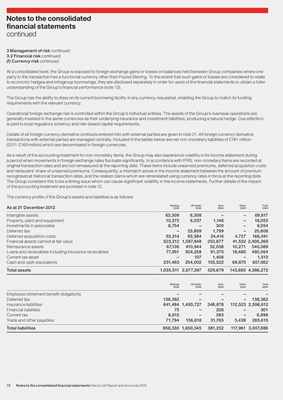
Notes to the consolidated
financial statements
continued
3 Management of risk continued
3.2 Financial risk continued
(f) Currency risk continued
At a consolidated level, the Group is exposed to foreign exchange gains or losses on balances held between Group companies where one
party to the transaction has a functional currency other than Pound Sterling. To the extent that such gains or losses are considered to relate
to economic hedges and intragroup borrowings, they are disclosed separately in order for users of the financial statements to obtain a fuller
understanding of the Group’s financial performance (note 13).
The Group has the ability to draw on its current borrowing facility in any currency requested, enabling the Group to match its funding
requirements with the relevant currency.
Operational foreign exchange risk is controlled within the Group’s individual entities. The assets of the Group’s overseas operations are
generally invested in the same currencies as their underlying insurance and investment liabilities, producing a natural hedge. Due attention
is paid to local regulatory solvency and risk-based capital requirements.
Details of all foreign currency derivative contracts entered into with external parties are given in note 21. All foreign currency derivative
transactions with external parties are managed centrally. Included in the tables below are net non-monetary liabilities of £181 million
(2011: £169 million) which are denominated in foreign currencies.
As a result of the accounting treatment for non-monetary items, the Group may also experience volatility in its income statement during
a period when movements in foreign exchange rates fluctuate significantly. In accordance with IFRS, non-monetary items are recorded at
original transaction rates and are not remeasured at the reporting date. These items include unearned premiums, deferred acquisition costs
and reinsurers’ share of unearned premiums. Consequently, a mismatch arises in the income statement between the amount of premium
recognised at historical transaction rates, and the related claims which are retranslated using currency rates in force at the reporting date.
The Group considers this to be a timing issue which can cause significant volatility in the income statements. Further details of the impact
of the accounting treatment are provided in note 12.
The currency profile of the Group’s assets and liabilities is as follows:
Sterling US Dollar Euro Other Total
As at 31 December 2012 £000 £000 £000 £000 £000
Intangible assets 63,309 6,308 – – 69,617
Property, plant and equipment 10,372 6,537 1,146 – 18,055
Investments in associates 8,754 – 300 – 9,054
Deferred tax – 23,809 1,799 – 25,608
Deferred acquisition costs 53,314 83,584 24,416 4,727 166,041
Financial assets carried at fair value 523,212 1,587,848 253,677 41,532 2,406,269
Reinsurance assets 67,136 410,944 52,038 10,271 540,389
Loans and receivables including insurance receivables 77,951 304,258 91,375 18,480 492,064
Current tax asset – 107 1,406 – 1,513
Cash and cash equivalents 231,463 254,002 103,522 68,675 657,662
Total assets 1,035,511 2,677,397 529,679 143,685 4,386,272
Sterling US Dollar Euro Other Total
£000 £000 £000 £000 £000
Employee retirement benefit obligations – – – – –
Deferred tax 138,362 – – – 138,362
Insurance liabilities 641,484 1,493,727 348,878 112,523 2,596,612
Financial liabilities 75 – 226 – 301
Current tax 6,615 – 383 – 6,998
Trade and other payables 71,794 156,618 31,765 5,438 265,615
Total liabilities 858,330 1,650,345 381,252 117,961 3,007,888
72 Notes to the consolidated financial statements Hiscox Ltd Report and Accounts 2012